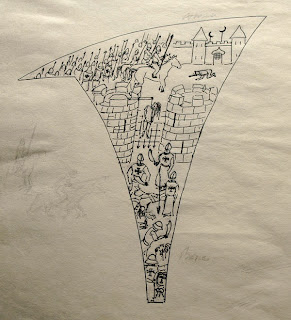Fig tree print
Friday evening. Years ago in Palmerston North, New Zealand.
On my way back to the boarding address I bought myself a bag (serious size) of
dried figs to help me through the weekend while swatting for exams coming up
the next week. As soon as I got through the door the bag was open and in spite
of exercising all the will power I could muster it lasted all but an hour and a
half. FINITO.
Tried it again a few years later in Opotiki. Faced with a
weekend by myself I got hold of another serious sized bag with dried figs.
Took one...another....then another and then I remembered the first bag.
Soooo... I put the bag in a cupboard in another room, safe...I thought...not
for long …….before I found the bag.
Some figs later I placed it behind a stack of plates so that
I would have to go down on my knees in an awkward position in order to get to
that bag. That I did and lo, surprise, I found those figs again. Anyway it
figures that in spite of all my heroic efforts those figs did not make it long
enough to see the end of the early evening news that Friday.
I just LUUUUVE figs. Dried, fresh, in brandy, with vanilla ice-cream, whatever.
Now we live in South France with four very good producing
fig trees on the property. It did not long for Cassy our Labrador to park
himself under the fig tree.
Cassy's favourite tree
He took care of anything up to about one meter
twenty. The birds took care of anything we couldn’t reach and we had what was
left.
Planted more fig trees
With fig smeared around my mouth and dirty fig fingers I decided to plant
a few more. We have now some late fruiting varieties as well. It all equates to
fig heaven.
Apart from some interesting facts like; its name “Ficus
carica” (the plant itself is totally unaware of its name. No one ever told it
by what name it grew in this world of ours), its curious fruit, a “syconium”, like a sack with a tiny hole at
the end through which tiny, tiny wasps, called “fig wasps” crawl inside. Those are the females of the species. The males come to life within this syconium and seek out the females and fertilise them. In
doing so, the tiny flowers inside this sack get fertilised as well. The female somehow gets
out again leaving a dead male behind. Thus the male never gets to see
daylight at all as it comes to life within the syconium and than dies after
producing offspring. His body becomes part of the mush after a bit of hydrolysis. Those wasps are so small
that they can literally crawl through the eye of a needle. They live in perfect
symbiosis with this amazing plant.
If you want to satisfy your curiosity there are many articles on the net covering a lot more information and history surrounding this plant and it's all really very
interesting.
I spent some time in the sun making a drawing of a nice
looking branch. From the sketch I chose the part I wanted to make a print of. It was transferred to a sheet of 6 mm course linoleum which had to be sanded down to obtain a smooth surface.
The sketch and what I chose to be the print
After that the cutting. Being mid summer and in the South of France it was seriously hot. During the day it would get up to 41 degrees C in the atelier, thus I did most of the work during the late evening.
Working in the evening during the summer heat
With a very sharp gouge it was a joy to cut, following the veining of the leaves. Actually I thought the block looked nice in its own right.
Cutting of the block
Finally the block was cut. I mounted it beforehand on a sheet of 6 mm MDF and varnished it to protect it from water while wet sanding it. Now it was time to ink it. I used a water soluble printing ink for it which can be used for intaglio and relief printing. I thought of giving it a try. That actually worked like a charm especially when it came to cleaning up. Fantastic not having to use mineral turpentine etc.
Inking
After that on the printer. Having the sheet of linoleum sitting proud on the MDF, I made a surround of just 1 mm thinner than the lino which could be removed when inking.
On the press
Et voila. Just needed to make couple of proofs and straight away nice rich black prints without the problems normally encountered printing large black areas.
Pulled print
Using this ink worked so well that I used it on an earlier carved block. It made for a satisfying evening of printing with good results.
Days result
Finally the prints needed drying. I made an impromptu drying rack of slats and sheets of anything laying around to leave the prints to dry for two weeks before touching them.
Drying prints






















































